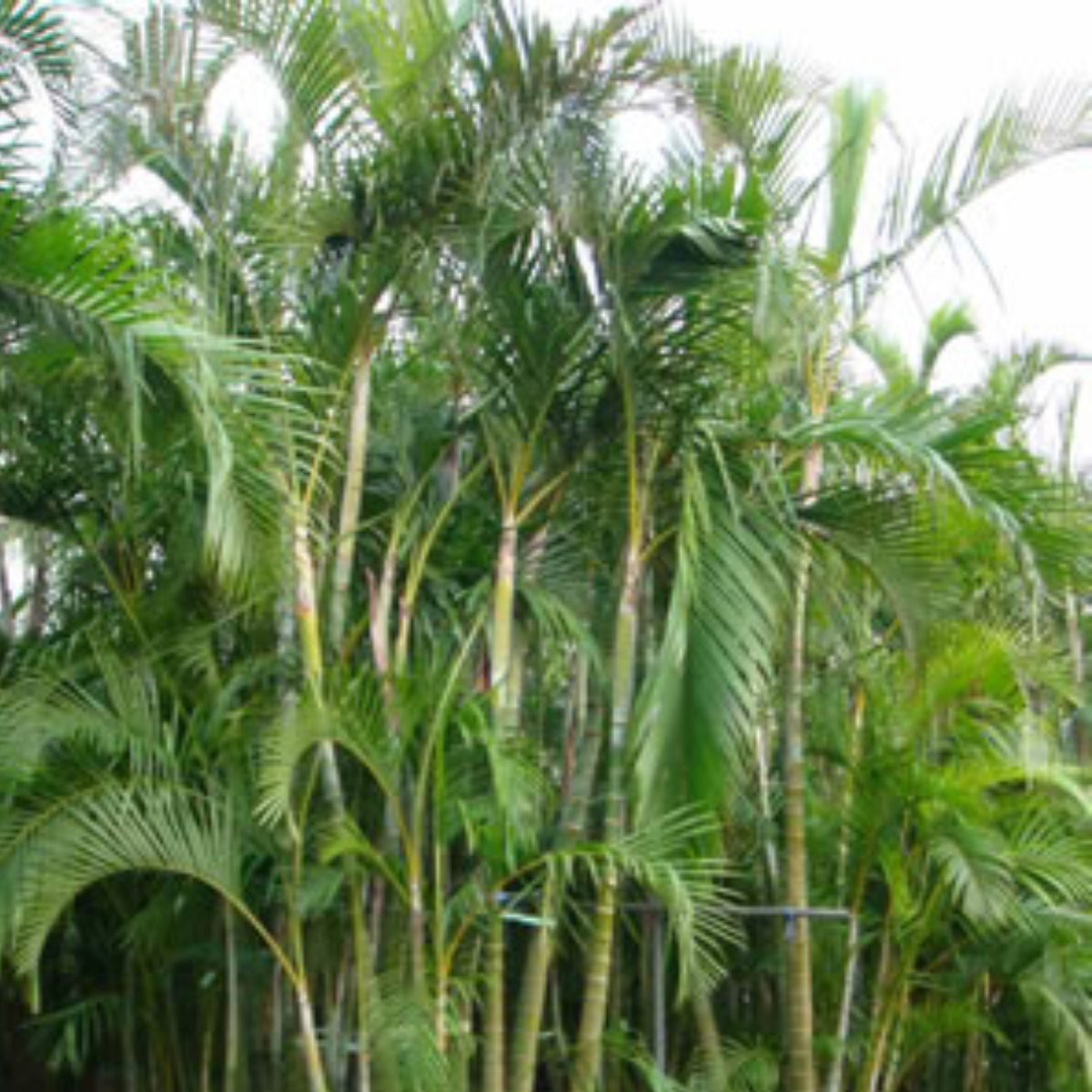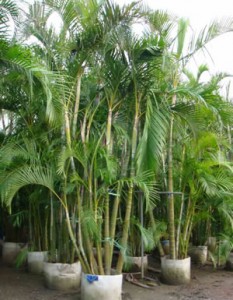Synonyms: Dypsis lutescens
Distribution & Habitat: found in humid tropical forests from Malaysia to the Solomon Islands.
Common Names:
Yellow palm, Golden Cane Palm, Areca Palm, Golden Fruited Palm, Yellow Butterfly Palm, Golden Feather Palm
Description: Only one species of the genus Chrysalidocarpus is widely grown as a house plant: Chrysalidocarpus lutescens. This plant - which used to be known as Areca lutescens and is still sometimes called areca palm- produces many reed like stems in clusters, and these stems carry arching fronds on 60 cm long, deeply furrowed, yellowish orange stalks. The fronds of a 1.5 m high Chrysalidocarpus can be up to 1 m long and are divided into many rather stiff, glossy, yellowish green segments which are up to 60 cm long and 1 cm wide. The segments are arranged in almost opposite pairs on a prominent midrib. Older stems are marked like bamboo canes.
Development is relatively slow. An annual increase of 15-20 cm in height is average for a plant grown in good light at normal room temperature. Specimens in pots normally produce many small suckers at the base; these can be used for propagation.
Proper Care:
[caption id="attachment_70" align="aligncenter" width="300"]
 Chrysalidocarpus lutescens - Care[/caption]
Chrysalidocarpus lutescens - Care[/caption]Light: These palms do best in direct sunlight filtered through something like a translucent blind or curtain.
Temperature: Normally warm room temperatures are suitable. A minimum temperature of 13C is ideal for healthy growth though the plant will survive quite cool winters as a patio plant.
Watering: Water plentifully as often as necessary to keep the potting mixture thoroughly moist, but never allow the pot to stand in water. If the temperature falls as low as 13C, give only enough water to keep the mixture from drying out completely.
Feeding: Apply a liquid fertilizer to actively growing plants about every two weeks or so.
Potting and repotting: Use a soil based potting mixture. Move plants into pots one size larger every second spring until maximum convenient pot size is reached; thereafter, top-dress with fresh potting mixture annually. Make sure that the mixture is firmly packed around the roots, but be careful not to damage the thick taproots.
Propagation: Propagation can be achieved by fresh seed sown at a temperature of at least 18C in late spring. If seed can be acquired, it is quite easy to germinate in the home, but it will take several years to produce a plant with adult characteristics. These plants can be increased much more simply by means of the basal suckers, which should be removed for propagation in spring. The ideal sucker is about 30 cm height and has some root growth (this can be ascertained when the plant is taken out of its pot for the operation).
Plant each sucker in a 10-12 cm pot filled with a moistened mixture of two-thirds soil-based potting mixture and one-third coarse sand or a substance such as perlite (the latter component to encourage active root growth). Enclose the whole in a plastic bag and keep it in a warm room in medium light for four to six weeks. Thereafter, remove the plastic bag and water the potted sucker sparingly, allowing the top centimetre of the mixture to dry out between waterings, until growth indicates that roots are well established. Then treat the plant virtually as a mature specimen, but do not feed it for the first three or four months. It need not be moved into standard mixture until the following spring.
Usage
Because of its dense and clustering growth habit, Chrysalidocarpus primarily is used as a shrub, hedge or screen in subtropical or tropical landscapes. There is almost no limit to the uses of the Chrysalidocarpus lutescens, and because it is easy to grow and readily available, it has become a landscaping standard. It also can be used as a specimen palm to show of its golden canes, especially if older leaves are pruned. In cooler climates, Chrysalidocarpus lutescens is commonly used in interior design to add a tropical touch.
General air purifier, especially as it grows larger. Chrysalidocarpus lutescens is known for being one of the better performers in purifying the air.
Outdoor growing
Growing in full sun where it makes an excellent specimen or screen to the rather dense shade of patios, porches or as house plants, Chrysalidocarpus lutescens prefers fertile, well-drained, acid soil. Small palms benefit from some shade until they are about one metre tall and palms should be watered during periods of drought. They require regular fertilizer applications to maintain a good appearance. Young palms in full sun and those in high pH soils develop yellow leaves. Older leaves on plants of any age become chlorotic, frequently from a deficiency of potassium. Affected leaves are often speckled with bronze or yellow. Yellow Butterfly Palm is moderately salt-tolerant.
Summary:
Chrysalidocarpus lutescens
These plants require some special conditions and are unlikely to thrive without them.
CHARACTERISTICS:
Foliage green
Shape bushy
PROPER CARE:
Watering in rest period sparingly
Watering in active growth period plentifully
Light bright filtered
Temperature in rest period min 13C max 24C
Temperature in active growth period min 16C max 24C
Humidity high



